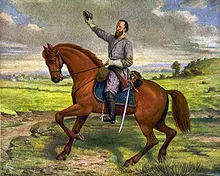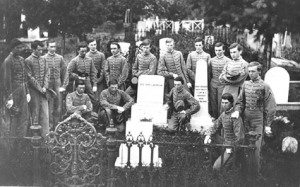General Thomas Jonathan Stonewall Jackson is an iconic Confederate general and is considered by many to be one of the best generals in the Civil War.
According to various sources, Stonewall Jackson had a number of strange habits, one of them being that he often walked around with his hand in the air to balance the blood in his body.
According to the memoir of General Jackson’s old friend Dabney Maury, titled Recollections of a Virginian in the Mexican, Indian, and Civil Wars, Stonewall Jackson believed one side of his body was heavier than the other and he would raise his arm to correct the problem:
“At that time he was convinced that one of his legs was bigger than the other, and that one of his arms was likewise unduly heavy. He had acquired the habit of raising the heavy arm straight up so that, as he said, the blood would run back into his body and lighten it.”
Yet another book, titled Whatever You Resolve to be: Essays on Stonewall Jackson, says this was just one of many strange beliefs that General Jackson held:
“Acquaintances raised their eyebrows, however, when in addition to these legitimate maladies [rheumatism and digestive issues] and treatments Jackson would complain that the two halves of his body did not act in accord, or that the origin of his sore throat could be found in his liver. Dabney Maury reported that Jackson would occasionally thrust an arm in the air because he believed one of his limbs to be heavier than the other. By elevating the offending appendage, Stonewall thought, the blood would rush back into his body and thus temporarily rectify the imbalance. Dick Ewell remembered the his commander refused pepper to avoid weakening his left leg, and D.B. Conrad claimed that Jackson would sometimes pack himself in wet sheets before attending Sunday services.”
Jackson’s acquaintances said he would often walk around or ride his horse with his hand in the air so the blood would flow from one side of his body to the other.

Painting of Stonewall Jackson’s famous gesture
Modern physicians suggest Jackson’s feeling of unbalance may have been the result of a diaphragmatic hernia, which also gave him stomach problems and caused him discomfort while sitting.
Incidentally, Stonewall Jackson received a bullet or shrapnel wound in his hand as a result of holding it up in the air during the first battle of Bull Run.
The wound was not deadly but a surgeon recommended amputating his damaged middle finger. Fortunately, the wound healed without any need for amputation.
Stonewall Jackson later had his left arm amputated after he was shot multiple times by friendly fire during the Battle of Chancellorsville in May of 1863. His arm was buried near Chancellorsville with a marker that read “Arm of Stonewall Jackson.”

Grave marker for Stonewall Jackson’s arm
Jackson survived the wounds and the amputation but died from pneumonia a week later. His body was buried in a plot at the Stonewall Jackson Memorial Cemetery in Lexington, Va before being reburied under a monument in the cemetery.

Stonewall Jackson’s original grave in Lexington, Va
Sources:
Recollections of a Virginian in the Mexican, Indian, and Civil Wars by Dabney Herndon Maury
Whatever You Resolve to be: Essays on Stonewall Jackson by A. Wilson Greene
How the North Won: a Military History of the Civil War; Herman Hattaway, Archer Jones; 1983
Thomas Francis Meagher and the Irish Brigade in the Civil War; Daniel M. Callaghan; 2006
National Parks Traveler: Where Is Stonewall Jackson’s Arm Buried?: www.nationalparkstraveler.com/podcast/2010/where-general-stonewall-jacksons-arm-buried7164


There is some incorrect information in the article. When the doctor near the First Battle of Bull Run said all he knew to do for Jackson’s hand was amputate, General Jackson sought out Dr. Hunter McGuire who saved the injured finger! Glenna Tilman, great granddaughter of Dr. Hunter H. McGuire.
Hi Glenna, I’m Mike. Id love to talk to you more about your great-grandfather. Would you be able to email me? [email protected]